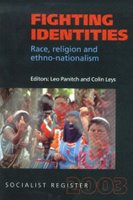The Constituent Assembly for Stable ‘Democracy’ or for uninterrupted Democratisation?
A substantial portion of the following reflections on Nepal was jotted down several days ago, but they seem still relevant.
1
Stable democracy is the end of democratisation. This statement is ambiguous - on the one hand, it means that democratisation leads to stable democracy, but on the other it also means that the latter actually ends the process of democratisation. Isn’t it true that all stable formal democracies are realisation of particular processes of democratisation? Isn’t it also true that the stability of these democracies depends on how much the ritual of elections and the cacophony of parliamentary halls and senates are able to control the popular assertion on the streets and in every walk of life?
2
In Nepal, this tussle between democracy and democratisation is very intensive. Till recently especially during the phase of the people’s war the forces representing each of them were easily identifiable since they were generally mutually exclusive, but after April 2006 both are on the same turf trying to overpower one another. The only consistent forces are the royalty and the imperialists - the former is waging an existential struggle, while the latter have to make best out of the worst situation. And all others are inconsistent in varying degrees. The non-communist forces of democracy are evidently still afraid of any drastic break from the past - the royalty and their own past practices. The royal nostalgia looms heavily on the election manifestos of the Nepali Congress and UML, even when they officially declare themselves as republicans. They are afraid of any radical change in the legitimation process. They are unable to give away the ritualism and ceremonialism that characterised the polity which they profess to challenge. They still need a ceremonial patriarch in whose name they will rule.
3
Everybody knows that it was the mass agitation that forced the royalty and foreign interests on defensive. Even after the restoration of the old parliament it was the continued presence of masses on the streets that coerced the restored leadership to inch forward to further democracy.
4
By becoming part of the government that is non-committal to any radical change unless forced, the Maoists perhaps became vulnerable to all the pitfalls of power politics in a competitive set-up. However the greatest strength or safeguard for them is their recognition and commitment to two-line struggle within their own ranks - between the tendencies of compromise and of uninterrupted transformation. They are aware that their radicalism lies in intensifying this struggle at every level. If we find today an apparent inconsistency between the Maoists in the government and those on the streets, it is the open realisation of this two-line struggle, which tempers one another not allowing the former to settle with status quoism. Recent statements by Prachanda, Baburam Bhattarai and Mohan Baidya, where they stressed on the need for giving “top priority to the street struggle at this juncture”, reflect the Maoists’ resolution to remain as forces of democratisation, rather than a stability factor for a democracy of an elitist minority and the depoliticised majority.
5
Definitely, this does not go well with the scheme for democracy as visualised by the hegemonic forces. They need stability; democracy too is needed just to have a stable environment, as a scheme to bribe away the representatives of those who shout on the streets. If democracy goes beyond this scheme, it is an aberration and anarchy - if workers assert themselves on their workplace or the landless demand their share on the resources, they are harming the property rights of the individuals. Democracy is a privilege, which must not be practiced everyday and everywhere. It is in this sense we can understand the conflict between the forces of democracy and those of democratisation. Democratisation in this regard can be understood as perpetual expansion of democracy beyond the confines of established institutions.
6
It was expected that after locking up the arms of the Maoist army, the Maoists would be “disarmed” and locked up in barracks. It is forgotten that a revolutionary army is first and foremost politically armed and always on watch out. The recent controversies on the activities of the Young Communist League are symptomatic of the impossible demands posed by the status quo on the revolutionary forces. Another controversy that has come up is regarding the issue of returning land to the deposed landlords. It is part of the hegemonic expectations, which seek to do away with any impact of the previous parallel revolutionary government on the future political economy of Nepal. Even if the Maoists officially may agree to it, the popular energy that they have unleashed in their decade-long people’s war will obviously reassert itself, despite all odds. This popular energy is evident in various self-determination movements, which have startled all the political forces in the country with their vigour.
7
Among these movements, the Madheshi (Terai) struggle clearly stands out, not only for its vigour but also for its peculiar constitution. Evidently, the various Madheshi identities have long been oppressed and suppressed in the overall Nepali set-up. But the recent attempt to homogenize Madheshi as a singular regional identity beyond divisions - caste and class - is a phenomenon that can only be understood by revealing the interplay of class, national and international forces behind it.
8
The Madheshi (Terai) region is agriculturally the most productive region in the country. Historically there has been a strong section of landed and propertied gentry in this region which has continued to oppose any systematic land redistribution efforts. Until now this section has been able to preclude such possibility through their opportunist lobbying and support to various political formations. It has time and again resisted any efforts to decrease the land ceilings. Unsurprisingly, it will see the Maoists with their commitment to radical land reforms as a grave threat. With the genuine federalist self-determination movements rising throughout the country to hasten and shape up the future Nepal, this section along with other Indo-Nepali businessmen with evident backing from the mellowed down monarchy supporters utilized sections of the Terai movement to turn anti-Maoist. In order to homogenise the Madheshi sentiment against the Maoists, the Terai ruling class and political elites have been utilising the apprehension that the radical land reforms might relocate non-Terai landless into the region. The following quote from Sarita Giri of Nepal Sadbhawana Party (Anandi Devi), one of the political parties claiming to fight for the Madheshi rights reveals much of the class-fear among the leadership of the Madheshis:
“As a consequence of [the] 1990 movement, Communists (led by hill elites) emerged as a formidable new force. [The] Revolutionary land reform agenda has been now their political agenda. But it would be naive to say that it was no more the agenda of Nepali Congress. Prime minister Sher Bahadur Deuba ha[d] agreed to reduce the ceiling to 4 to 5 bighas from 11 bighas in Madhesh. It was due to the movement led by Nepal Sadbhawana Party and supported by madheshi elites across parties that the government dropped its agenda. And now in 2007 they are the Maoists who have designed to march ahead with their agenda of revolutionary land reform. It has explicitly been mentioned in the Interim Constitution. This time too, Nepal Sadbhawana Party (Anandi Devi) has written note of dissent against the revolutionary land reform program. The aim behind such an agenda is obviously to enhance the control of hill centric state over madhesh. This is the context against which the current Madheshi movement and its demands of republicanism, autonomy, self determination and federalism should be understood.”
Even Jwala Singh, a militant Madhesi leader demanded that, “The land of Madheshis captured by Maoists should be given back”.
Obviously these sections of the Terai leadership will be all the more anxious, as the Maoists have already included the demand for ‘land to the tiller’ in their Commitment Document for the Constituent Assembly elections.
9
Furthermore, the Terai region being geographically, culturally and economically closer to the only immediate imperialist force and agency in the region, India, is also open to various kinds of imperialist manipulation. In recent years, India with its rising economic interests beyond its territory has used all sorts of “identities” to assert a diasporic homogeny under the garb of which it can support its cross-border political economic expansion. It is not very surprising that this expansionist tenor was firmly and vocally established by the Rightist forces in India. It can in fact be comfortably said that the rightists became a legitimate force in India only with the rise of neoliberalism, when Indian capital found Indianness, Hinduism etc to be effective in its “free” market consolidation and operation globally. One needs to cursorily go through the widely circulated weekly of Hindu fascists, Organiser and its chatterbox journalism to grasp the confident obscenity of Indian expansionism in its extreme. Recently it invented “The Western-Christian agenda in Kathmandu” and “the Christian leadership of the Maoists”, lamenting the threat to the “Hindu civilisation”:
“The bells are tolling, not just for the Nepalese monarchy, but also for the Hindu culture and civilisation of the nation.”
It is a known fact that the Hindu rightists in India have been outspoken against the republican and democratisation processes in Nepal, and have been very active recently in the Terai region. It is this transnational unity among Hindu fascists with its base in India, which acts as a major weapon of active imperialist intervention, besides the usual economic threat of the flight of capital and the diplomatic diatribes.
10
It is evident that delays that marred the implementation of the anti-royalist agenda to which various democratic forces agreed have given a significant time for the reactionary forces to consolidate. It will be interesting to observe the various political realignments before, during and after the Constituent Assembly elections.
11
The Maoists claim that the main basis of the new constitution will be “the mandate of the 10 years People’s War and 19 days people’s Movement”. They see, as Maoist leader Badal explains, the Constituent Assembly as “the process of building new Nepal. We are advancing through the Constituent Assembly as the process of institutionalising new Nepal by the representatives elected directly in the participation of the people.[sic!] We raised the agenda of the CA through revolt and movement; institutionalized it and we are in the stage of its implementation. The process has been advanced ahead to carry out movement up to conclusion.” Obviously this reinterpretation of the CA as a process, if legitimised through elections and if the Maoists continue to adher to it, will be a death knell for the reactionary forces in and around Nepal.






0 Comments:
Post a Comment
<< Home